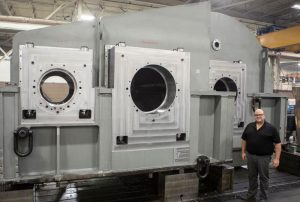Large Precision Machining: What Sets It Apart?
Large precision machining stands as a cornerstone in modern manufacturing, distinguished by its unparalleled accuracy and capability to handle sizable components. Understanding the intricacies that set it apart is essential for industries seeking precision and reliability in their manufacturing processes.

Precision and Accuracy
At the heart of large precision machining lies its ability to achieve extraordinary levels of precision. With tolerances reaching as tight as 0.0001 inches, these machines excel in producing components with exacting specifications. Every cut, every contour is executed with meticulous accuracy, ensuring the utmost quality in the final product.
Size and Capacity
What truly sets large precision machining apart is its capacity to handle sizable components. These machines boast impressive size capabilities, with maximum workpiece dimensions ranging from several feet to over 100 feet in length. This immense scale opens doors to a myriad of possibilities, from machining large aerospace structures to fabricating massive industrial components.
Power and Efficiency
Large precision machining harnesses formidable power to tackle even the most demanding machining tasks. Spindle powers exceeding 100 horsepower drive cutting tools through the toughest materials with ease, ensuring swift and efficient material removal. With rapid traverse rates reaching 2000 inches per minute or more, these machines deliver exceptional efficiency, reducing production times and maximizing output.
Material Versatility
Versatility is another hallmark of large precision machining. These machines are equipped to handle an extensive range of materials, including aerospace-grade alloys, stainless steel, titanium, and exotic metals. From the toughest alloys to the most delicate composites, large precision machining offers the flexibility to work with diverse materials, catering to the needs of various industries.
Quality Assurance
Quality is non-negotiable in large precision machining. Rigorous quality control measures, such as in-process inspections, coordinate measuring machine (CMM) verification, and comprehensive testing protocols, ensure that each component meets stringent quality standards. This relentless pursuit of quality guarantees reliability and consistency in the final product.
Lifecycle and Maintenance
With proper maintenance and care, large precision machining centers can enjoy a long and productive lifecycle. Routine maintenance tasks, including spindle lubrication, tool calibration, and machine alignment, are essential to uphold performance and longevity. By investing in preventative maintenance measures, businesses can mitigate downtime and prolong the operational lifespan of their machining equipment.
In conclusion, large precision machining stands as a pinnacle of precision and capability in modern manufacturing. With its unrivaled precision, immense size capacity, formidable power, and versatility, it offers a pathway to excellence in producing large-scale components with uncompromising quality and efficiency.